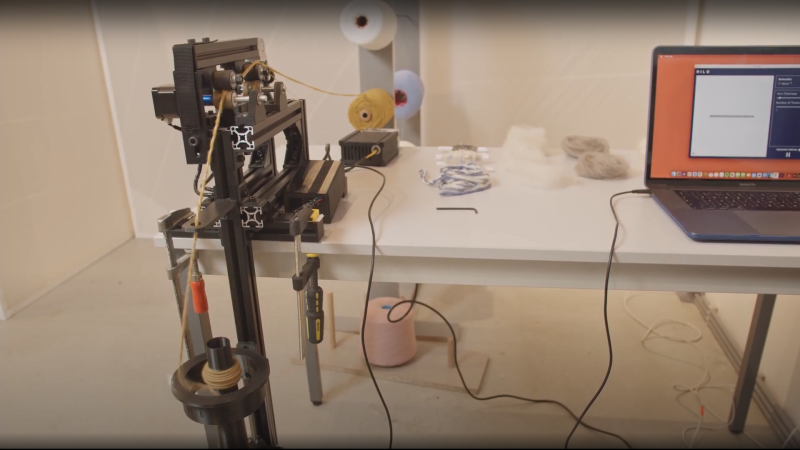The team at the Berlin-based Studio HILO has been working on ideas and tools around developing a more open approach to small-scale textile production environments. Leveraging open-source platforms and tools, the team has come up with a simple open hardware spinning machine that can be used for interactive yarn production, right on the desktop. The frame is built with 3030 profile aluminium extrusions, with a handful of 3D printed, and a smidge of laser cut parts. Motion is thanks to, you guessed it, NEMA 17 stepper motors and the once ubiquitous Arduino Mega 2560 plus RAMPS 1.4 combination that many people will be very familiar with.
The project really shines on the documentation side of things, with the project GitLab positively dripping with well-organised information. One minor niggle is that you’ll need access to a polyjet or very accurate multi-material 3D printer to run off the drive wheel and the associated trailing wheel. We’re sure there’s a simple enough way to do it without those tools, for those sufficiently motivated.
We liked the use of Arduino for the firmware, keeping things simple, and in the same vein, Processing for the user interface. That makes sending values from the on-screen slider controls over the USB a piece of cake. Processing doesn’t seem to pop up on these pages too often, which is a shame as it’s a great tool to have at one’s disposal. On the subject of the user interface, it looks like for now only basic parameters can be tweaked on the fly, with some more subtle parameters needing fixing at firmware compilation time. With a bit more time, we’re sure the project will flesh out a bit more, and that area will be improved.
Of course, if you only have raw fibers, that are not appropriately aligned, you need a carder, like this one maybe?
Thanks [Daniel] for the tip!

















Confusingly contradictory- you state that: “…you’ll need access to a polyjet or very accurate multi-material 3D printer to run off the drive wheel and …associated…”, but then correct yourself, saying: “We’re sure there’s a simple enough way to do it without those tools…”. Is this impossible to make without the specialty machines, or is it simple to do it without the machines?
i have to disagree, It’s hardly confusing. nor do i interpret this as the author correcting themselves.
seems perfectly reasonable to draw attention to a caveat and then express general faith in the audiences ability to .. you know .. hack!
This is precisely the intent. To use, as-is you need their tools, but as a group of resourceful hackers we can always find another way. No confusion at all. If you have the money, you can always get the awkward bits printed by a commercial outfit – lots of companies in China will do it for a pretty good price if you shop around a bit.
Not knowing much about how thread is made, I watched the video only to find out that something called “hand drafting” is needed for this machine to “spin” the thread.
So, I would like to know more about the hand drafting process.
Years ago, I did watch a young woman using a spinning wheel to make wool yarn.
I guess I was expecting this machine to do that as well.
That whole process looked just bad when compared to hand spinning. I can spin straight from the roving without any drafting. That machine didn’t look very precise either, I’m pretty sure it can’t spin shorter staple length at all. There are already machines for spinning yarn too and they can actually do what hand spinners can as well. So this really feels more like a toy.
Wow!
My head is spinning in jargon!
First hand drafting,
Then roving,
Shorter staple length…
Maybe I should just carefully back away before I get sucked into another dimension!
B^)